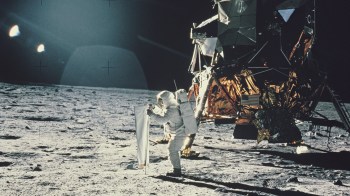Today on the Marketplace Morning Report, we spoke to Charles Fishman, author of The Big Thirst: The Secret Life and Turbulent Future of Water. In his new book, Fishman explains that historically, humans have had a very luxurious relationship with water — how we use it, how we access it, how it’s valued — but now, everything about water is about to change.
As part of our Big Book Blog, Fishman has provided us with a list of facts that might affect how you use and consume the world’s most precious resource.
10 Things That Will Change How You Think About Water
By Charles Fishman
Most of the water on Earth is water you’ve never heard of. We learn in school that water comes in three states, solid (ice), liquid, and gas (steam). But water exists in a fourth state, “molecular water,” fused into a layer of rock 400 miles deep in Earth. The fourth state of water isn’t trivial, it’s where most of Earth’s water is — three or four times as much water locked into rocks beneath our feet as is in all the oceans of Earth.
That new flat-screen TV has a hidden water hose running to it. A typical American uses 99 gallons of water a day for cooking, cleaning and sanitation. But the electricity a typical American uses each day — just at home — requires 250 gallons of water per person to generate.
Water and energy share an intimate relationship. Electricity requires water and water requires electricity. In the U.S., 49 percent of all water used each day goes to generate electricity. And in California, for instance, 20 percent of the state’s electricity is used to move and process water.
The U.S. actually uses less water in 2010 than it did in 1980. Illustrating that it is possible to grow and modernize an economy dramatically, while transforming water use, the United States actually uses less total water to create a $13 trillion economy in 2010 than it did to create a $6 trillion economy in 1980 — despite the addition of 70 million more people.
Clean water has saved, and lengthened, millions of American lives. Between 1900 and 1936, the installation of clean water systems in U.S. cities cut the rate of child deaths in half. During those years, life expectancy in the U.S. rose from 47 to 63 years, largely because of the advent of clean water systems.
Business is way ahead of ordinary people and government in seeing the dawn of a new era of water, a need for “smart water.” Monsanto is genetically engineering crops to use less water. Coke, Intel, and Campbell’s Soup now measure and disclose their water use and their “water productivity.” IBM has cut water use in its microchip operations 5 percent per year in each of the last 5 years — and created a water business to teach other companies how to do the same thing. GE has a water division (GE Water) that does $5 billion in business a year — GE Water would be a Fortune 500 company by itself.
Bottled water looks like a harmless indulgence, but it consumes enormous resources: Americans spend $21 billion a year buying bottled water. That’s almost as much as we spend maintaining our entire drinking water system.
Water cannot be used up. Water is essential to almost every process of nature, geology, chemistry, and human life. And yet, unlike, for instance, fossil fuels, water emerges from everything we do to it as … water. It may need to be cleaned, but it is otherwise immediately ready to be re-used again as water. Water is the ultimate sustainable resource, tirelessly resilient.
New water sources are right at hand. Two of the easiest sources of water we already have. Cities around the world leak huge amounts of water from their mains — 15 percent in the U.S., 19 percent in the UK, 29 percent in Italy. Fixing leaks instantly “harvests” that water. And we can easily purify wastewater back to drinking water standards, for all kinds of re-use — our water was all once dinosaur pee, of course.
Access to water: 1.6 billion people in the world — one in four — have to walk at least 1 km each day to get water and carry it home, or depend on someone who does. Just to provide basic water for a family of four — 50 gallons — that means carrying (on your head) 400 pounds of water, walking 1 km or more, for as many trips a day as necessary.
Be sure to check out the Big Book Blog for more information on The Big Thirst, including Marketplace’s interview with Charles Fishman and an excerpt from the book.
There’s a lot happening in the world. Through it all, Marketplace is here for you.
You rely on Marketplace to break down the world’s events and tell you how it affects you in a fact-based, approachable way. We rely on your financial support to keep making that possible.
Your donation today powers the independent journalism that you rely on. For just $5/month, you can help sustain Marketplace so we can keep reporting on the things that matter to you.


















